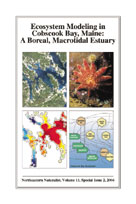The nutrient distribution in the highly productive, macrotidal Cobscook Bay, located in the northern Gulf of Maine, was investigated through a series of spring-neap cruises during the spring, summer, and fall of 1995. Sampling design included three 5-station transects at major constrictions in the Bay and 21 peripheral stations in the principal coves and sub-embayments. Results indicate that Cobscook Bay is nutrient rich throughout the year and is potentially eutrophic. Plots of salinity against nitrate show that this is a totally natural circumstance brought about by an abundant supply of nutrients, most importantly nitrate, from the adjacent Gulf of Maine. Predictive nutrient algorithms fitted with a hydrodynamic model emphasize the high nitrate water entering the Bay from the seaward end and diminishing in concentration with distance from the mouth. The plant biomass produced is heavily grazed, resulting in high ammonium concentrations from excretion and regeneration. The high ammonium concentrations and its incomplete re-utilization by the phytoplankton strongly suggest that plant biomass is controlled by grazing. In other words, despite a high natural nutrient loading, natural grazing processes serve to limit the accumulation of plant material and potential eutrophication. Comparing all potential nitrogen fluxes indicates that man-made contributions are not significant to the overall nutrient budget of Cobscook Bay, although they may have local impacts.
How to translate text using browser tools
1 December 2004
Nutrient Sources and Distributions in Cobscook Bay
Chris Garside,
Jean C. Garside
ACCESS THE FULL ARTICLE

Northeastern Naturalist
Vol. 11 • No. sp2
December 2004
Vol. 11 • No. sp2
December 2004




